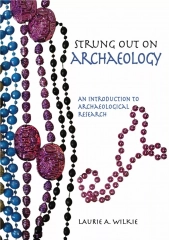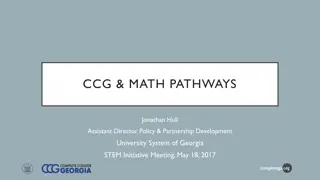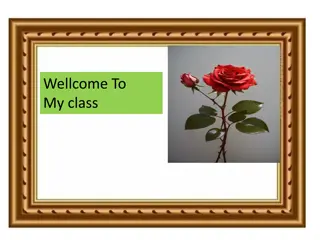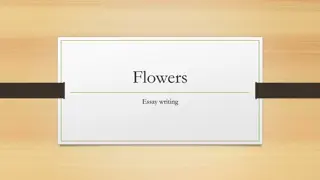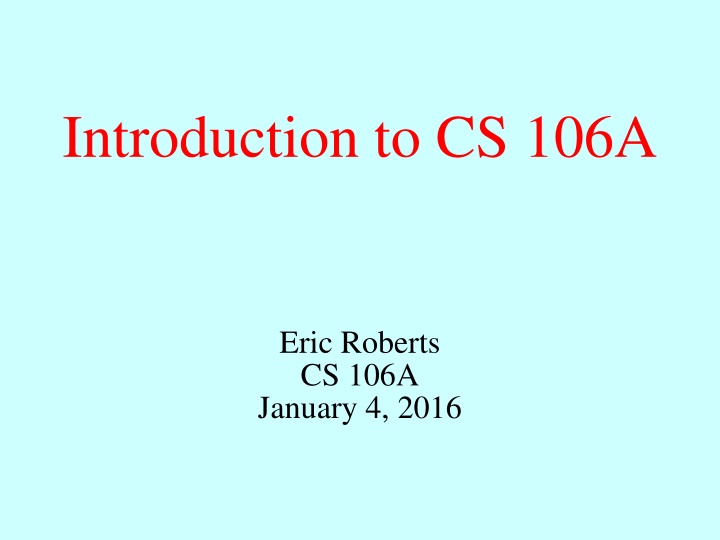
Computer Science at Stanford: CS106A Course Overview
Discover the CS106A course at Stanford University taught by Professor Eric Roberts. Explore the syllabus, administrative notes, and reasons to study computer science. Learn about the staff, important dates, and how to enroll in the course.
Uploaded on | 0 Views
Download Presentation

Please find below an Image/Link to download the presentation.
The content on the website is provided AS IS for your information and personal use only. It may not be sold, licensed, or shared on other websites without obtaining consent from the author. If you encounter any issues during the download, it is possible that the publisher has removed the file from their server.
You are allowed to download the files provided on this website for personal or commercial use, subject to the condition that they are used lawfully. All files are the property of their respective owners.
The content on the website is provided AS IS for your information and personal use only. It may not be sold, licensed, or shared on other websites without obtaining consent from the author.
E N D
Presentation Transcript
Introduction to CS 106A Eric Roberts CS 106A January 4, 2016
Why Study Computer Science Phil Levis, http://csl.stanford.edu/~pal/ed/ Doctorate Master s Bachelor s Job openings 161,857 129,045 94,889 57,127 55,208 49,200 31,357 10,075 Physical Sciences Biological Sciences Engineering Computer Science The educational data comes from the National Center for Education Statistics IPEDS (Integrated Postsecondary Education Data System) Data Center. The data used is for degrees granted in the 2008-2009 academic year. We are very happy with the students that we get from this university. . . . We just wish we could hire two to three times as many of them. Bill Gates at Stanford, February 19, 2008 The employment data comes from the Department of Labor s Occupational Outlook Handbook for 2010-11. This handbook includes employment for 2008 as well as a 10-year projection to 2018. I manually selected which occupations mapped to which degrees. I calculated job openings per year as 10% of the expected job growth over 2008-2018 plus 2.5% of the number of jobs in 2008. This second term describes the number of jobs opening as people retire. It assumes that people work for 40 years and leave a job at a uniform rate; the latter is of course not true in difficult economic times.
CS 106A Staff Professor: Eric Roberts eroberts@cs.stanford.edu Office Hours (Gates 202): Tuesdays 9:30 11:00 Wednesdays 4:00 5:00 Head TA: Alisha Adam aadam@stanford.edu Office Hours (Gates B-02): TBA
Important Administrative Notes You must sign up for a section to be enrolled in the course. Section signups will start at 5:00P.M. on Thursday and close at 5:00P.M. on Sunday. Be sure to sign up during that time at http://cs198.stanford.edu/section/ Undergraduates must take CS106A for 5 units.Unfortunately, the default on Axess is 3 units, so make sure that you change this value as you register. All handouts, assignments, lecture slides, and announcements are posted on the course web site at http://cs106a.stanford.edu/ The midterm is given at two scheduled times as shown in Handout #2. Special arrangements can be made for those who cannot make either time.
SyllabusWeek 1 January 4 6 8 Administration CS and the Honor Code Meet Karel the Robot Simple Karel programs Extending the Karel class The concept of inheritance Control structures in Karel Problem-solving in Karel Program decomposition The idea of an algorithm Read: Karel, Chapters 1-3 Read: Karel, Chapters 4-6
SyllabusWeek 2 11 13 15 Programming by example Classes and objects The Program hierarchy Simple graphical objects Variables and values Arithmetic expressions Common idioms Control statements Boolean data Simple animations Read: Chapter 4 Due: HW #1 (Karel) Read: Java, Chapter 1 Read: Chapters 2 and 3
SyllabusWeek 3 18 20 22 Martin Luther King, Jr. Day Methods Objects and classes Constructors Inheritance The role of parameters Optional film: Dr. King s 1963 speech I Have A Dream Read: Sections 6.1-6.2 Due: Karel contest Read: Chapter 6 Due: HW #2 (Simple Java)
SyllabusWeek 4 25 27 29 The acm.graphicspackage Responding to mouse events The Java listener model Graphical structures GPolygonand GCompound Creating compound objects Character data Using Java s Stringclass Read: Sections 9.1-9.3 Read: Sections 10.1-10.3 Read: Section 9.4 Due: Parameter Problem Set Read: Sections 8.1-8.4
SyllabusWeek 5 February 1 3 5 The ArrayListclass The HashMap class String manipulation Problem-solving with strings Cryptography Overview of Assignment #4 Read: Section 8.5 Due: HW #3 (Breakout) Read: Draft chapter handout
SyllabusWeek 6 8 10 12 Debugging strategies Data representation Arrays Midterm Exam Tuesday, February 9 9:00A.M. or 3:00P.M. Due: Graphics contest Read: Chapter 7 Read: Section 11.1-11.4
SyllabusWeek 7 15 17 19 Multidimensional arrays Pixel arrays Image manipulation Swing interactors The JComponent hierarchy Action listeners Presidents Day (no class) Read: Sections 11.6-11.7 Due: HW #4 (Cryptography) Read: Sections 10.5-10.7
SyllabusWeek 8 22 24 26 Using data files Java collection classes Iterators Large-scale data structures Data-driven programs Read: Section 12.4 Read: Chapter 13 Due: HW #5 (ImageShop)
SyllabusWeek 9 29 March 2 4 Overview of Adventure! Sorting and searching Algorithmic analysis Layout managers Designing GUIs Read: Adventure handout Read: Sections 12.1-12.3 Due: Sections 10.5-10.8
Dead Week and Beyond 7 9 11 Looking ahead Concurrency Programming patterns Frontiers of computing (optional) Due: HW #6 (Adventure) Due: Adventure contest Read: Chapter 14 Review session: Sunday, March 13 7:00-9:00P.M. Final exam: Monday, March 14 8:30-11:30A.M.
Assignments in CS 106A Assignments in CS106A are due at 5:00P.M. Assignments that come in after 5:00 will be considered late. Everyone in CS 106A starts the quarter with two latedays that you can use at any time you need some extra time. In my courses, late days correspond to class meetings, so that, if an assignment is due on Wednesday and you turn it in on Friday, that counts as onelate day. Extensions can be approved only by the TA, Alisha Adam. Assignments are graded by your section leader, who discusses your work in an interactive, one-on-one grading session. Each assignment is given two grades: one on functionality and one on programming style. Style matters. Companies in Silicon Valley expect Stanford graduates to understand how to write code that other programmers can maintain.
The CS 106A Grading Scale Functionality and style grades for the assignments use the following scale: A submission so good it makes you weep. Exceeds requirements. Satisfies all requirements of the assignment. Meets most requirements, but with some problems. Some more serious problems. Even worse than that. Why did you turn this in?
Contests CS 106A will have three contests as follows: The Karel Contest associated with Assignment #1 The Graphics Contest associated with Assignment #3 The Adventure Contest associated with Assignment #6 First prize in the contest is a score of 100% on one of the graded components of the course, typically the final exam. As an additional incentive, entering any of the contests gives you chances to win an additional grand prize in a random drawing at the end of the quarter. Entering a contest also earns housepoints for your class in the style of the Hogwarts School from Harry Potter. Securing a runner-up prize or an honorable mention on any contest gives you additional chances in the random drawing, as does having an assignment submitted as a ++ candidate.
Honor Code Rules Rule 1: You must not look at solutions or program code that is not your own. Rule 2: You must not share your solution code with other students. Rule 3: You must indicate on your submission any assistance you received.
Meet Karel the Robot The only other objects that exist in Karel s world are beepers, Initially, Karel understands only four primitive commands: Karel s world is composed of streets and avenues numbered from the southwest corner. (As in Manhattan, streets run east- west and avenues run north-south.) In this world, Karel is walls in the interior of the world that block Karel s passage. In this world, for example, I ve added a beeper to the corner turnLeft() Turn 90 degrees to the left Karel the Robot was developed here at Stanford by Richard Pattis over 30 years ago. Since then Karel has given many generations of CS 106A students a gentleintroduction to programming and problem solving. facing east at the corner of 1st Street and 1st Avenue. of 1st Street and 2nd Avenue. pickBeeper() Pick up a beeper from the current square putBeeper() Put down a beeper on the current square Karel s world is surrounded by a solid wall through which it cannot move. Depending on the problem, there may also be which are small plastic cones that emit a quiet beeping noise. move() Move forward one square 3 + + + + + + + + + + 2 + + + + + 1 1 2 3 4 5
Your First Challenge How would you program Karel to pick up the beeper and transport it to the top of the ledge? Karel should drop the beeper at the corner of 2ndStreetand4thAvenue and then continue one more corner to the east, ending up on 5thAvenue. 3 + + + + + + + + + + 2 + + + + + 1 1 2 3 4 5

